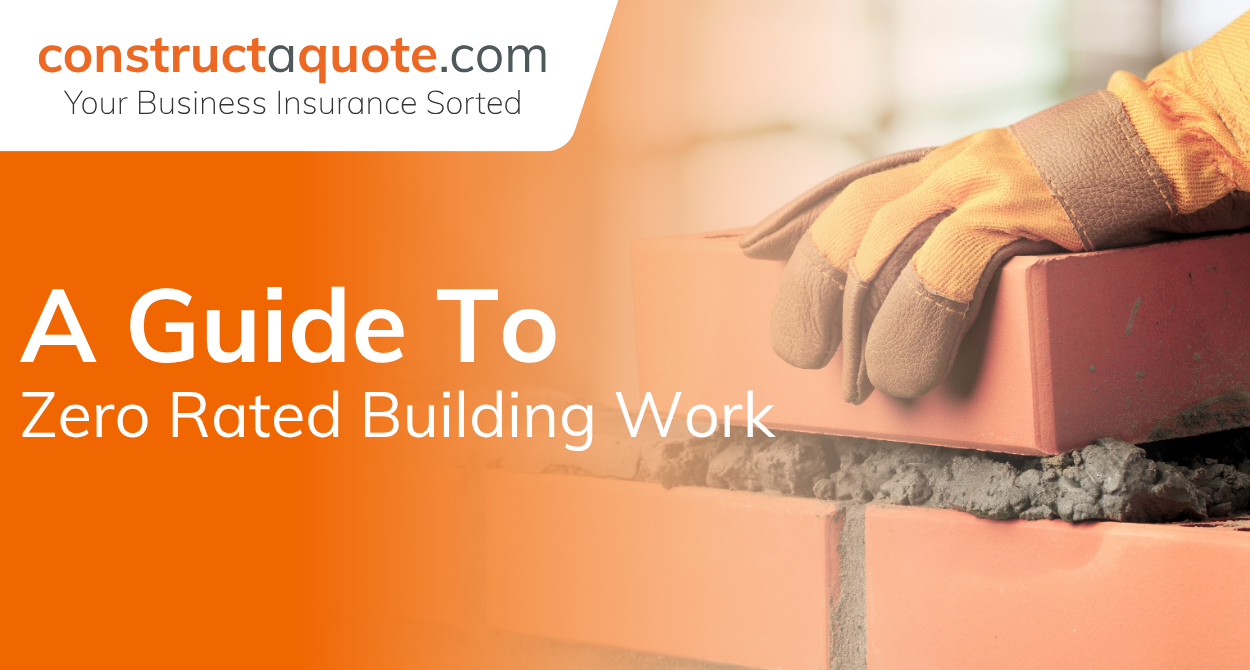by James Watkins - 20 June 2016


If you’re confused about zero rated VAT for building work you’re not alone. Many small builders and contractors find the ins and outs of VAT for the construction industry confusing. With business so competitive at the moment the last thing you want to be doing is overcharging for VAT.
To help you find our way round what is and what’s not VAT exempt we’ve take a look at the guidance and put together a road map for you. This short guide should help you make sense of the HMRC guidance and help make sure you aren’t overpricing or losing business by charging VAT when it does not apply.
Normally building work is charged at the normal VAT rate which at present is 20%, however there are some times when no VAT charged for building work, or a reduced rate is charged. Generally speaking no VAT is chargeable new houses or flats (new build) or on alterations to suit people with disabilities.These VAT categories are known as the “zero-rate” VAT band. For some kinds of work, a reduced rate of VAT is payable, usually 5%.
Here’s a quick summary of zero, reduced and standard rated work:
Zero rated
• Construction of a new house or flat
• Supplying or installing goods for a disabled person in their own home
• Making alterations to suit a disabled person
• Buildings used for charitable purposes, listed buildings, school buildings, student accommodation
For a complete list of zero rated construction schemes check detailed guidance from HMRC.
Reduced rate
• Converting a building into a house or flat
• Renovating or altering an empty house or flat
• Supplying and installing mobility aids for elderly people
• Supplying and installing certain energy saving materials and equipment
• Supplying and installing certain heating systems and security goods when grant funded
• Connecting or reconnecting to the mains gas
• Converting a residential property into a different residential use – eg a house into flats
Standard rate
• All other construction work including for example,
• Building an extension, annex or granny flat
• Loft conversions
• Repairs and renovations
New Build
If you are a tradesman working on a new house or flat the work you do should be eligible for the zero rate of VAT. However there are several conditions that must be met to qualify for zero rating.
• It must be self-contained living accommodation, without any internal doors or connections to other houses or flats.
• It must also have proper (full, approved) planning permission in place
• It must also be able to be sold in its own right (ie not as part of any other property).
Any work needed to prepare for construction is also zero-rated if you are supplying a ‘design and build’ service where the client pays you for the entire job (drawings, planning permissions, surveyors and engineers fees etc) even though these professional fees will be charged to you with standard rate VAT.
The labour costs that allow the building to be used – for example, work to provide power or water, building paths, walls, gates is also zero rated.
Items normally included in a new building should also be charged at zero-rate VAT. This includes fixtures and fittings such as bathroom taps, kitchen sinks, windows, toilets and shower units.
Heating and hot water appliances, environmental systems, safety and security systems and some other appliances may also be zero-rated. Note gas and electrical appliances are standard rated, carpets are standard rated but wood or laminate flooring is zero rated. Check the detailed guidance if you are in doubt.
In most cases the zero-rate applies to charges for both your labour and cost of materials.
If you are working on a building that will be for mixed use, for example a shop with a flat over, then only the work on the flat will be zero rated. You will have to separate out your standard and zero rated VAT for this kind of a project and there’s guidance to help you do this on the HMRC pages.
If you build a garage at the same time as a new flat or house is built then this work can also count as zero-rated. External tennis courts and swimming pools are always standard-rated for VAT.
On a new build there are several types of work you can’t zero-rate, including on-site catering services and anything above the minimum required soft landscaping, so exotic planting, garden ornaments and features are all standard rated.
Construction work for people with disabilities
You can zero-rate alterations you make to a disabled person’s home to improve accessibility or usability. If the work you do is to make the persons’ home more accessible from the outside, or to make it easier to move around inside, it can be zero-rated. For example building a ramp or widening a doorway or passageway, or adapting a bathroom to suit a disabled persons’ needs will all count as zero-rated.
There is also zero-rate VAT for all the essential work you do when installing, repairing or maintaining an ordinary vertical lift in a disabled person’s home.
If you have to use an area that was previously part of another room when renovating a disabled person’s house then restoring the room to its original size will be zero-rated.
When the building work is done to a disabled person’s home but paid for by a local authority it does not qualify for a zero-rating. If the disabled person gets paid a grant by the local authority and your supply is actually being made to the disabled individual, the work will qualify for zero-rating.
Certain goods supplied for disabled people can be subject to the zero-rate. If you supply or install adjustable beds, hoists, chair and stair lifts, sanitary devices, alarms or any other equipment or appliances designed solely for use by a disabled person then these goods are in the zero-rate tax band. This also applies to general-purpose goods adapted to suit a disabled person’s condition.
This short guide should give you an idea of what’s commonly zero rated and what’s not, but we haven’t covered everything here, so for detailed guidance on buildings used for charitable purposes, listed building and other zero rated construction work or just to check the rating of your project, the HMRC pages on VAT for the construction industry are a must read. They are comprehensive, easy to search and easy to read. If you think you’re doing work that’s zero rated or could qualify for a reduced rate, check the HMRC guidance to make sure you’ve got the latest information to hand.

by Charlotte Houghton - 7 October 2020
by constructaquote - 6 October 2020
by Charlotte Houghton - 29 September 2020
by Charlotte Houghton - 24 September 2020